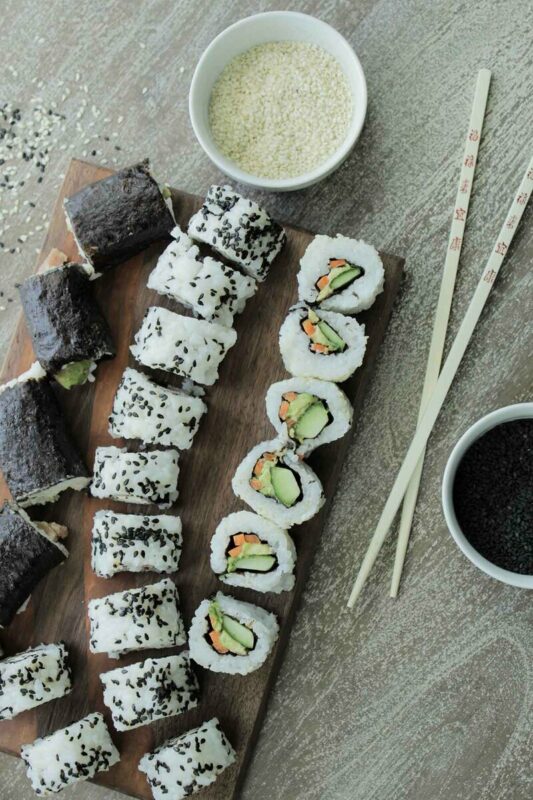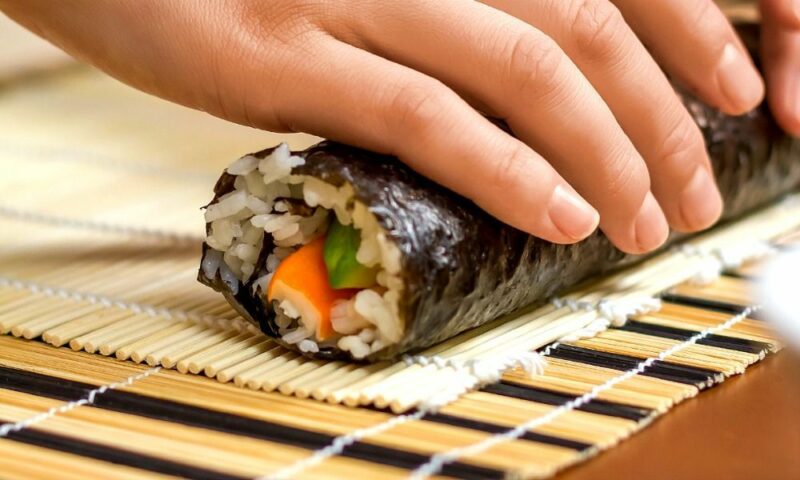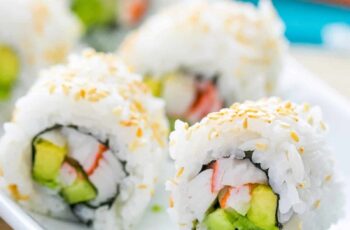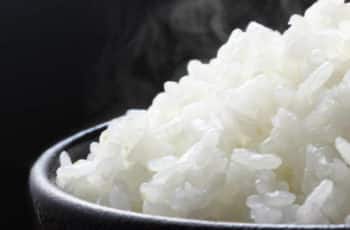Table of contents
I. Introduction
Sushi is a popular Japanese dish that has gained worldwide popularity over the years. One of the essential components of sushi is the rice used in its preparation. Sushi rice is a short-grain variety of rice that has unique characteristics that make it ideal for making sushi.
Sushi rice is different from regular rice due to its grain size and shape, starch content, acidity level, flavor, and texture. It is shorter, fatter, and stickier than long-grain rice, which gives it the necessary adhesive quality to hold the sushi roll together.
Using the right type of rice is crucial for making sushi because it affects the taste, texture, and appearance of the final product. Therefore, using sushi rice is highly recommended for achieving the perfect sushi experience.
The purpose of this article is to explore the differences between sushi rice and regular rice and determine whether regular rice can be used as a substitute for making sushi. This article will also provide a step-by-step guide on how to make sushi rice with regular rice and compare the taste, texture, and appearance of sushi made with sushi rice versus regular rice. By the end of this article, you will have a better understanding of the role of rice in sushi-making and the best type of rice to use for making sushi.

Can I use regular rice instead of sushi rice for making sushi-2
II. Differences between sushi rice and regular rice
A. Grain size and shape Sushi rice is a short-grain variety of rice that is rounder, fatter, and shorter than long-grain rice. Its small size and plumpness give it a sticky texture, which makes it easier to mold and hold its shape. Regular rice, on the other hand, can be of different varieties, including long-grain and medium-grain rice, which have a slender and elongated shape. The elongated shape of regular rice makes it less sticky and harder to mold, making it unsuitable for making sushi.
B. Starch content Sushi rice has a high starch content, which gives it its characteristic sticky texture. The high starch content makes sushi rice perfect for holding its shape when rolled, as it clings together more easily. In contrast, regular rice has lower starch content, which makes it less sticky, and it can be easily separated, making it unsuitable for making sushi.
C. Acidity level Sushi rice has a slightly acidic taste that complements the other ingredients used in sushi. The acidity of sushi rice comes from the vinegar seasoning used in its preparation. Regular rice, however, does not have the same acidity level as sushi rice, which can affect the overall taste of the sushi.
D. Flavor and aroma Sushi rice has a distinct flavor and aroma that comes from the seasoning used during its preparation. Sushi rice is seasoned with a mixture of vinegar, sugar, and salt, which gives it a slightly sweet and tangy taste that complements the other ingredients in sushi. Regular rice, on the other hand, does not have the same flavor and aroma as sushi rice, which can affect the overall taste of the sushi.
E. Texture The texture of sushi rice is sticky, which makes it easier to mold and hold its shape. The stickiness of sushi rice comes from its high starch content, which makes it cling together more easily. In contrast, regular rice has a less sticky texture, which can make it challenging to mold and shape. The texture of regular rice can also affect the overall texture of the sushi, making it less appealing to eat.
III. Can regular rice be used for making sushi?
A. Advantages and disadvantages of using regular rice Using regular rice instead of sushi rice for making sushi can be advantageous in terms of availability and cost. Regular rice is widely available and less expensive than sushi rice, which can be beneficial for home cooks who want to make sushi on a budget. However, using regular rice can also have some disadvantages, such as the lack of stickiness, which can make it challenging to roll and shape the sushi. Regular rice also lacks the distinct flavor and aroma of sushi rice, which can affect the overall taste of the sushi.
B. Types of regular rice that can be used for making sushi Not all types of regular rice are suitable for making sushi. The best type of regular rice to use for making sushi is short-grain rice, which has a similar shape and texture to sushi rice. Other types of rice, such as medium-grain and long-grain rice, are not recommended for making sushi because of their elongated shape, which makes them less sticky and harder to mold.
C. Techniques for preparing regular rice for sushi To make regular rice suitable for making sushi, it needs to be rinsed thoroughly and soaked in water for at least 30 minutes to remove excess starch. The rice is then cooked with slightly less water than usual to make it slightly sticky. Vinegar seasoning is then added to the cooked rice to give it a similar acidity level and flavor as sushi rice.

Can I use regular rice instead of sushi rice for making sushi
IV. How to make sushi rice with regular rice
A. Ingredients needed To make sushi rice with regular rice, you will need:
- 2 cups of short-grain rice
- 2 1/2 cups of water
- 1/4 cup of rice vinegar
- 2 tablespoons of sugar
- 1 teaspoon of salt
B. Step-by-step process
- Rinse the rice in a colander until the water runs clear.
- Soak the rice in water for 30 minutes.
- Drain the rice and transfer it to a pot.
- Add 2 1/2 cups of water to the pot and bring to a boil.
- Reduce the heat to low and cover the pot with a tight-fitting lid.
- Cook the rice for 15-20 minutes or until the water is absorbed.
- Remove the pot from the heat and let the rice sit for 10-15 minutes.
- In a small bowl, mix together the rice vinegar, sugar, and salt until the sugar and salt dissolve.
- Transfer the cooked rice to a large bowl and add the vinegar mixture, stirring gently to coat the rice evenly.
- Cover the bowl with a damp cloth and let the rice cool to room temperature.
C. Tips for achieving the desired texture and flavor To achieve the desired texture and flavor of sushi rice with regular rice, it is essential to rinse and soak the rice thoroughly before cooking. The rice should be slightly sticky, but not too wet or too dry. The vinegar seasoning should be added gradually, tasting as you go to achieve the desired level of acidity and sweetness. Finally, the rice should be cooled to room temperature before using it for making sushi to avoid melting or hardening the other ingredients in the sushi roll.
V. Comparison of sushi rice and regular rice sushi
- A. Taste Sushi rice has a distinct flavor that is slightly sweet and sour, thanks to the vinegar seasoning. On the other hand, regular rice sushi can have a milder taste, depending on the type of rice used and the amount of vinegar seasoning added.
- B. Texture Sushi rice has a sticky and chewy texture that makes it easy to roll and shape into sushi. Regular rice sushi can have a less sticky texture, which can make it more challenging to roll and shape.
- C. Appearance Sushi rice has a glossy and shiny appearance, while regular rice sushi can look duller and less appetizing.
- D. Difficulty in preparation Preparing sushi rice requires more effort and attention to detail than regular rice sushi. Sushi rice needs to be rinsed and soaked before cooking, and the vinegar seasoning needs to be added gradually and carefully to achieve the right level of acidity and sweetness. Regular rice sushi, on the other hand, only needs to be cooked and seasoned with vinegar.
- E. Overall quality Overall, sushi rice sushi is considered to be of higher quality and more authentic than regular rice sushi. However, using regular rice can still result in a delicious and satisfying sushi roll if prepared correctly.
VI. Conclusion
A. Summary of the article In summary, sushi rice is the preferred rice for making sushi because of its sticky texture, distinct flavor, and glossy appearance. However, regular rice can be used as a substitute if prepared correctly.
B. Recommendations for using sushi rice vs. regular rice For the best results, it is recommended to use sushi rice when making sushi. However, if sushi rice is not available or too expensive, short-grain regular rice can be used as a substitute. It is essential to rinse and soak the rice thoroughly, use vinegar seasoning to add flavor and acidity, and cool the rice to room temperature before using it to make sushi.
C. Final thoughts on making sushi with regular rice While using regular rice for making sushi can be challenging, it is still possible to make delicious sushi rolls with this type of rice. With the right techniques and attention to detail, regular rice sushi can be a satisfying and budget-friendly alternative to sushi rice sushi.








